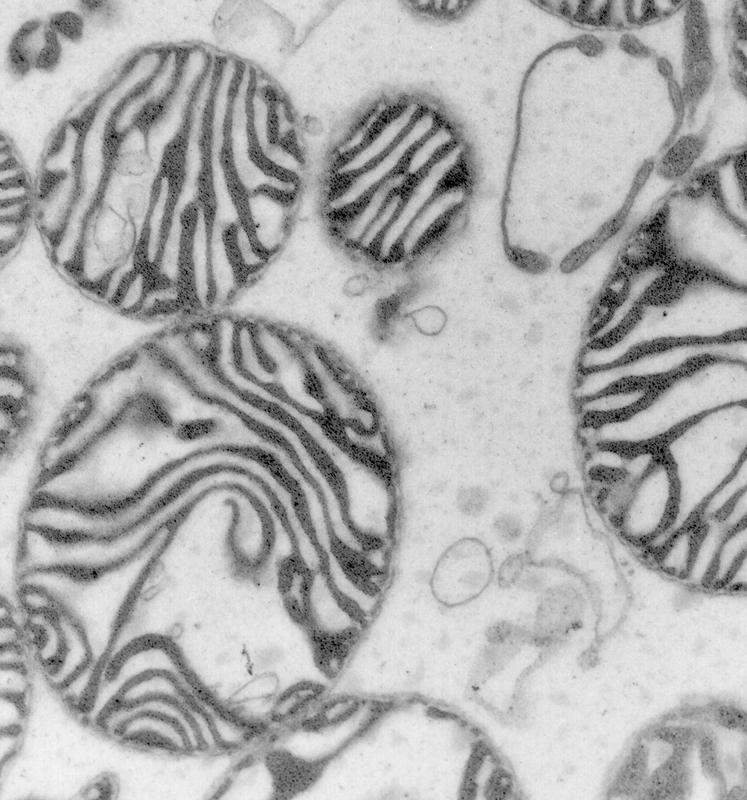„Science“-Study: Proteins surf to mitochondria – Novel transport pathway discovered

The microscope image shows mitochondria, the cell's power plants. Credits: AG Herrmann
Protein aggregation can be a critical problem leading to human pathologies such as Alzheimer’s or Parkinson’s disease.
Mitochondria, the compartments that produce most of the cellular energy, contain surface receptors, which facilitate protein uptake. “These receptors specifically recognize mitochondrial proteins and direct them through pores into the interior of mitochondria”, explains Prof. Johannes Herrmann, a specialist for mitochondrial biology.
“But, so far, we had no idea what these proteins encounter before they reach the mitochondrial surface”. “It was just assumed that newly synthesized proteins are directly targeted to their destination compartment”.
In a close collaboration with Professor Maya Schuldiner from the Weizmann Institute in Rehovot, Israel, Herrmann’s team observed that mitochondrial proteins are initially targeted to the surface of the endoplasmic reticulum (ER). The ER is a cellular compartment that serves as a central sorting station to deliver proteins to various cellular structures.
The new import pathway is termed ER-SURF, “since proteins basically surf along the ER surface” explains Katja Hansen, a PhD student in Prof. Herrmann’s lab and first author of the Science paper. Hansen established a genetic screen to identify novel components relevant for intracellular protein transport. She explains “we were able to identify specific ER-associated proteins as being critical for the transport of proteins to the mitochondrial surface”
The ER serves thereby as a buffer system. “The newly synthesized proteins, often prone to misfold and aggregate, are bound and stored on the ER surface until they can be passed on to mitochondria” explains Herrmann. “Thereby, ER-surf maintains proteins in a transport-competent conformation and prevents their aggregation. Such protein aggregates can be detrimental for cells and are thought to underlie the development of many diseases.”
Herrmann‘s team will now try to unravel the relevance of their ER-surf mechanism in the context of human diseases. “In particular, neurodegenerative disorders such as Alzheimer’s or Parkinson’s disease are caused by accumulating protein aggregates” says Herrmann. If the mechanisms that lead to the formation of these aggregates are better understood, we might be able to identify strategies to treat and cure these diseases.
Further studies are needed to unravel whether the ER-surf pathway is also relevant for the targeting of proteins to other cellular compartments.
Prof. Dr. Johannes Herrmann
Cell Biology, University of Kaiserslautern, Germany
E-Mail: hannes.herrmann@biologie.uni-kl.de
Tel.: 0631 205-2406
„ER surface retrieval pathway safe-guards the import of mitochondrial membrane proteins in yeast.“ Hansen, K.G., Aviram, N., Laborenz, J., Bibi, C., Meyer, M., Spang, A., Schuldiner, M., Herrmann, J.M.
http://science.sciencemag.org/content/361/6407/1118
DOI: 10.1126/science.aar8174
Media Contact
More Information:
http://www.uni-kl.deAll latest news from the category: Life Sciences and Chemistry
Articles and reports from the Life Sciences and chemistry area deal with applied and basic research into modern biology, chemistry and human medicine.
Valuable information can be found on a range of life sciences fields including bacteriology, biochemistry, bionics, bioinformatics, biophysics, biotechnology, genetics, geobotany, human biology, marine biology, microbiology, molecular biology, cellular biology, zoology, bioinorganic chemistry, microchemistry and environmental chemistry.
Newest articles

Properties of new materials for microchips
… can now be measured well. Reseachers of Delft University of Technology demonstrated measuring performance properties of ultrathin silicon membranes. Making ever smaller and more powerful chips requires new ultrathin…

Floating solar’s potential
… to support sustainable development by addressing climate, water, and energy goals holistically. A new study published this week in Nature Energy raises the potential for floating solar photovoltaics (FPV)…

Skyrmions move at record speeds
… a step towards the computing of the future. An international research team led by scientists from the CNRS1 has discovered that the magnetic nanobubbles2 known as skyrmions can be…





















